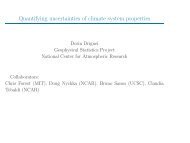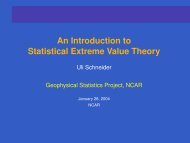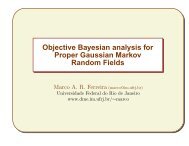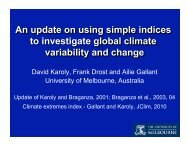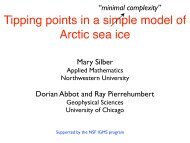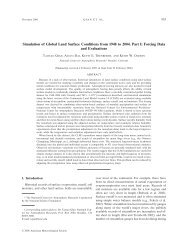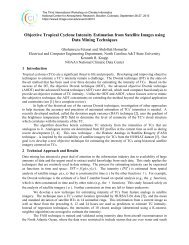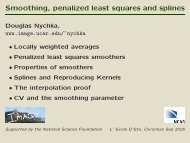A Spatial Analysis of Multivariate Output from Regional ... - IMAGe
A Spatial Analysis of Multivariate Output from Regional ... - IMAGe
A Spatial Analysis of Multivariate Output from Regional ... - IMAGe
Create successful ePaper yourself
Turn your PDF publications into a flip-book with our unique Google optimized e-Paper software.
Figure 3: Left frame shows scatterplot <strong>of</strong> a random sample <strong>of</strong> 10,000 values <strong>of</strong> φ 11 andφ 22 (1,000 <strong>from</strong> each <strong>of</strong> the 10 chains). Contours represent approximate 25, 50, and 75%contours <strong>of</strong> a kernel density estimate. Right frame shows kernel density estimates <strong>of</strong> themarginals for φ 11 (blue) and φ 22 (red).starting values for the conditional-dependence parameters were chosen uniformly acrossthe space <strong>of</strong> values that yield a positive-definite covariance matrix.A Gibbs sampler was implemented that involved three distinct regimes. In the firstregime (2500 iterations), each <strong>of</strong> the conditional-dependence parameters was updated oneat-a-timeusing a Metropolis-Hastings algorithm. Gaussian proposal distributions wereused, with periodic updates <strong>of</strong> the proposal variance to achieve an approximate 20% acceptancerate. In the second regime (the next 10,000 iterations), ρ, φ 12 , and φ 21 wereupdated simultaneously using a Metropolis-Hastings algorithm with a multivariate Gaussianproposal distribution. Again, the proposal covariance matrix was updated periodicallyto achieve an approximate 20% acceptance rate. Other conditional-dependence parameterswere still updated using univariate a Metropolis-Hastings algorithm. Finally, in the thirdregime (the last 10,000 iterations), ρ, φ 12 , and φ 21 were again updated simultaneously, butno further updates <strong>of</strong> the proposal distribution were made. Convergence <strong>of</strong> the posteriordistributions <strong>of</strong> the parameters in the MCMC was monitored using both graphical andnumerical methods (e.g., Gelman, 1996). Posterior distributions were then estimated bysampling <strong>from</strong> the third regime.17



